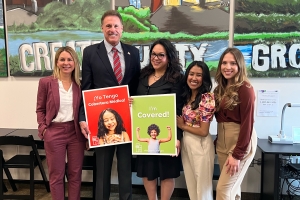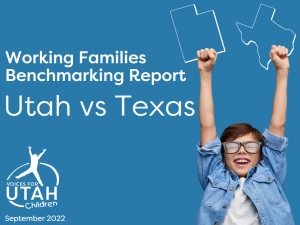Newsroom
Health
A Rough Legislative Session for Utah Kids (Again)
The 2024 Utah Legislative Session ended at midnight on Friday, March 1. For the Voices for Utah Children team, this session included supporting a lot of community engagement, working hard to protect the programs that protect Utah kids, and trying not to get distracted by outlandish efforts to "solve" problems that don't actually exist in Utah.
As usual, there were many, many missed opportunities for state leaders to improve the lives of Utah kids. Nonetheless, we managed to pull off some great victories - as always, in partnership with many supportive community members, our great partner organizations and supportive public servants.
We hosted six different public engagement events at the Capitol over seven weeks. Working closely with our community partners, we stopped some truly terrible legislation that literally threatened the lives of Utah kids who rely on Medicaid and CHIP. Thanks to many supportive child care professionals and working parents, we kept Utah's child care crisis in the media spotlight throughout the session.
For a deeper dive into our efforts in various policy areas, as well as a recap of what happened to the many different bills we were tracking, check out the virtual booklet below!
The Governor’s 2024 Budget: Hits and Misses for Utah Families
Governor Cox unveiled his budget last week, and the general direction of the budget is positive. Voices for Utah Children is interested in some specific components of the budget that directly impact Utah children and their families:
Public Education
$854 million increase, including a 5% jump in per-pupil funding and $55 million for rural schools
This is a much-needed investment in public education. We support the focus on rural schools and are anxious to see the details as they emerge. Public education consistently polls as a top priority for Utahns of all political parties and backgrounds.
Support for Utah Families
$4.7 million to expand Utah’s child tax credit and $5 million for accessible child care
We appreciate the fact that the Governor has begun to address the urgent needs of Utah families with young children. However, both allocations fall far short of the amount required to truly support and elevate these young families’ current needs. A truly impactful child tax credit would require an investment of at least $130 million, and the benefits in reducing child poverty in Utah would be substantial. Our recent report on child care in Utah clearly illustrates the need for bold action to support families in the workforce, who are struggling with the cost and unavailability of child care. The Governor’s $5M project will help very few Utah families and does not address the true need.
Housing
$128 million for homeless shelters and $30 million for deeply affordable housing
We support the Governor in his effort to better support the homeless residents of our state. We encourage a greater focus on expanding support for homeless children specifically. Early care and education opportunities for young children as well as more supportive programs for their parents and caregivers are critical to helping families find stable housing and better future opportunities. Investing in deeply affordable housing will help many Utah families.
Behavioral/Mental Health
$8 million for behavioral and mental health
This is not enough to address the current mental health needs of Utahns – in particular, those of our children and the folks tasked with raising them. We need more mental health professionals and greater access to services. We know this is a major concern for the Governor and we encourage increased strategic investment in this area.
It is also important to acknowledge and applaud some items the Governor wisely left out of his proposed budget:
No Proposed Tax Cuts
Utahns want to see more invested in our children while they are young, to prevent greater challenges later in life. It is our children who suffer most, when politicians toss our tax dollars away on polices that mostly benefit the wealthiest 1% of Utah households.
No Proposed Funding for Vouchers
Public funds should not be redirected to private entities. Utah needs an annual audit of the current program, to assess who is benefitting from school vouchers. In other states, the results are not good – vouchers are looking more and more like a tax break for wealthy families.
Bold Investments Needed for Utah's Children
Governor Cox's budget focuses on increasing funding for education, families, and affordable housing.
These are all areas where we believe bold investment is needed. We support the Governor in addressing these issues, but cannot overlook how this budget falls short in the face of the ongoing struggles faced by Utah families with children.
We encourage our Legislature to use the Governor’s budget as a roadmap and increase the allocations to the amount needed.
Our 2024 Legislative Agenda
At Voices for Utah Children, we always start with this guiding question: "Is it good for all kids?" That remains our north star at the outset of the 2024 legislative session, and is reflected in our top legislative priorities.
So, what’s good for all kids in 2024?
A Healthy Start!
A healthy start in life ensures a child's immediate well-being while laying a foundation for future success. We are steadfast in our commitment to championing policies that prioritize every child's physical, mental, and emotional well-being. Central to this commitment is our focus on improving Utah’s popular Medicaid and CHIP programs, which are pivotal in the lives of many Utah children and families.
This legislative session, a healthy start for kids looks like:
- Empowering Expectant Mothers: We support a proposal from Rep. Ray Ward (R-Bountiful) to increase access to health coverage for low-income and immigrant mothers-to-be.
- Increasing Access to Health Care: We support bills that aim to improve access to the vital healthcare services children and parents need, especially for those on Medicaid and CHIP.
- Protecting Health Coverage: We oppose any effort to defund, and exclude deserving children from, the Medicaid and CHIP programs that help thousands of Utah kids every year.
Early Learning and Care Opportunities!
The formative years of a child's life lay the foundation for their future, shaping their cognitive abilities, socio-emotional skills, and passion for learning. We will support efforts to increase access to home visiting programs and paid family leave, but ensuring consistent, quality, and affordable child care is our top priority.
This legislative session, early learning and care opportunities for kids looks like:
- Bolstering Access to Quality Child Care: We support the efforts of both Rep. Andrew Stoddard (D-Sandy) and Rep. Ashlee Matthews (D-Kearns) to extend the successful Office of Child Care stabilization grant program that has supported licensed child care programs statewide.
- Investing in High-Quality Preschool: We support an anticipated legislative proposal to streamline Utah’s existing high-quality school-readiness program and to make it available to more preschoolers statewide.
- Recruiting and Retaining Child Care Professionals: We support Rep. Matthews’ proposal to expand access to the Child Care Assistance Program for anyone working in the child care sector.
- Building New Child Care Businesses: We also support Rep. Matthews’ proposal to continue funding for work to develop and support new child care programs in rural, urban, and suburban areas.
To view a more comprehensive list of our 2024 early care and learning legislative priorities, click here.
Economic Stability for Families with Children!
Economic stability forms the bedrock of thriving families and vibrant communities. To ensure that young families in Utah have the support they need to afford basic necessities, we will advocate for increasing families’ access to Utah's earned income and child tax credits.
This legislative session, economic stability for families looks like:
- A Little Extra Help in the Early Years: We support HB 153, Rep. Susan Pulsipher’s (R-South Jordan) bill to expand Utah’s new Child Tax Credit, (currently only for children ages 1 to 3), to apply to children between 1 and 5 years of age. We also strongly recommend helping even more Utah families with young children by making the tax credit available for families with any child between birth and 5, and expanding it to include the thousands of lower- and moderate-income families who are currently excluded.
- Credit for Working Families with Kids: We support HB 149, Rep. Marsha Judkins’ (R-Provo) bill to expand Utah’s Earned Income Tax Credit so that more lower- and middle-income families with children can benefit.
Justice for Youth!
We want to ensure that all youth, including those who come into contact with the juvenile justice system, have access to interventions and supports that work for them and for their families. We are dedicated to advancing policies and recommendations that contribute to a more fair and equitable juvenile justice system for all Utah youth.
This legislative session, justice for youth looks like:
- Prioritizing School Safety: We are monitoring bills from Rep. Wilcox (R-Ogden) and the School Safety Task Force, including: HB 14, “School Threat Penalty Amendments” and HB 84, “School Safety Amendments.” We remain hopeful that these efforts will support a secure learning environment for all students, without contributing further to the School-to-Prison Pipeline.
Be an Advocate!
As we chart the path forward, one thing remains abundantly clear: the well-being, growth, and future of Utah's children rely on the decisions we make today. Each legislative session presents an opportunity—a chance to reaffirm our commitment, reevaluate our priorities, and reimagine a brighter, more inclusive future for all.
Together we can continue to make Utah a place where every child's potential is realized, their dreams are nurtured, and their voices are heard.
Below are some ways you can get involved this session.
Stay Informed with our Bill Tracker
Stay informed about important legislation we are watching and reach out to your local representatives to let them know how you feel about legislation that is important to you. We make it easy for you to subscribe and watch bills that you are most concerned about.
Join us for Legislative Session Days on the Hill
Join us at the Capitol, where we offer attendees the opportunity to engage in the legislative process on a specific issue area (health and/or child care). You'll have the chance to attend bill hearings, lobby your legislators, connect with fellow community advocates, and watch House and Senate floor debates. Click the button below for the dates/times of our meetings and to RSVP.
Celebrate Utah's Immigrant Community
In collaboration with our partners at UT With All Immigrants, the Center for Economic Opportunity and Belonging, and I Stand with Immigrants, we are organizing Immigrant Day on the Hill. Join us to discover ways to engage in Utah's civic life. Enjoy food, explore resource tables, participate in interactive activities, and entertainment. Everyone is invited to attend this free event!
Event Details: February 13, 2024, 3:30pm-5:30pm at the Capitol Rotunda, 350 State St, Salt Lake City, UT 84103
New State CHIP Program: A Win for Utah Children and Families
Wednesday, October 4, 2023
Voices for Utah Children is proud to have co-hosted the momentous unveiling of the new State CHIP Program during our morning press conference. We are grateful to have worked with Senator Luz Escamilla (D-Salt Lake City) and Representative Jim Dunnigan (R-Taylorsville) to support the passage of SB217: ChIldren’s Health Coverage Amendments that led to the creation of this program.
Voices for Utah Children's goal for every child in Utah to have health insurance and access to high-quality health care.
In our state, an estimated 7.9% of children in Utah do not have health insurance, with greater disparities amongst rural children and Latino children, placing Utah as 37th in the nation for insured children.
The State CHIP program will play a crucial role in bridging this gap by providing comprehensive healthcare coverage, so that children can access the medical care they need when they need to lead a healthier and more secure life.
This State CHIP Program is one piece of that puzzle.
The State CHIP program provides newly eligible children with comprehensive healthcare coverage, including well-child exams, immunizations, doctor visits, prescriptions, mental health services, and more, supporting more kids to have the opportunity to grow and thrive because of the access to coverage.
We are excited to continue working with Senator Escamilla, Rep. Jim Dunnnigan, and our 100% Kids Coverage Coalition, community and faith leaders, healthcare systems and providers, and more to outreach to all of our Utah families throughout the state so children get the health coverage and care they need. We know that this program will make a positive impact on many Utah families statewide and will get us closer to the goal of having all Utah kids covered.
Let’s get all Utah kiddos covered!
For more information about State CHIP for non-US citizens starting January 1, 2024 click here.
For more information about the new State CHIP program visit: https://chip.health.utah.gov/.
For more information about our 100% Kids Coverage Coalition visit: https://www.100percentkids.health/.
Utah Children's Budget 2023
The care for the children in our state and communities can be measured by our public investment in our smallest humans. From the fiscal year 2008 to 2022, Voices for Utah Children divided all state programs concerning children into seven categories, without regard to their location within the structure of state government to quantify the level of public funding and identify trends. The seven categories are:
- K-12 Education
- Health
- Food & Nutrition
- Early Childhood Education
- Child Welfare
- Juvenile Justice
- Income Support
An appendix of our tables, sources, methodology and description of programs can be found here.
How Much We Spend
The interactive circle chart below compares how much we spend by category, program, and source of funding, just use the filter and click the category to zoom in.
-
K-12 Education makes up 92% of the state-funded portion of the Children’s Budget, while the federal-funded portion is more diversified across categories.
Spending Trends
We compare the budget to FY2008 because that was a peak year in the economic cycle before The Great Recession and all figures have been adjusted for inflation, so they are comparable across time.
- From FY2008 to FY2022, total public investment in children increased by 43%, growing much faster than Utah’s public-school enrollment (district & charter schools) by 26%, or the child population ages 0-17 by 13% from 2008-2021.
The federal share of the Children's Budget has fluctuated between 18-26% but had its biggest increase at the beginning of the Great Recession and the Covid-19 Pandemic. This is also when state funding for the Children's Budget has declined, for example real state & local K-12 education funding fell by $206 million since FY2020, the largest two-year decline since the Great Recession in 2008-2010. Several years after the Great Recession the federal share of the Children’s Budget decreased and the state share started to increase again, something that will hopefully happen again as pandemic relief funding rolls back.
Funding Sources: Federal vs. State
When the categories are disaggregated by source of funding, Food & Nutrition, Income Support, Health, and Early Childhood Education programs are mainly funded by federal sources, and Child Welfare, K-12 Education, and Juvenile Justice programs are funded mainly by state sources. And since Amendment G passed and allowed the income tax to be used to fund programs for children (in addition to K-12 and some Early Childhood Education & Nutrition Programs), the Child Welfare, Juvenile Justice, and Health categories are funded primarily by the income tax. In FY2022, 98% of Juvenile Justice, 100% of Child Welfare, and 88% of Health categories of the state funded Children's Budget were funded by the income tax totaling to $475 M.
When examining the state-funded portion of the budget since FY2008 each category has a different story.
- Juvenile Justice programs declined the most in dollar amount, $32.9 M or 28% mainly due to a reduction in correctional facility and rural programs and it also had an increase in early intervention services which advocates consider to be a goal of juvenile justice reform.
- Child Welfare programs declined by 16% or $21.8 M, mainly from the Service Delivery program which funds caseworkers to deliver child welfare, youth, and domestic violence services.
- Income Support declined 49% or $2.1 M and appears to be more cyclical, rising and falling with the Great Recession. Interestingly, the TANF grant is a mix of state and federal funds, and only a small amount goes to Income Support or cash assistance.[i]
- Food & Nutrition increased by 56% or $19.7 M due to an increase in liquor & wine tax revenues which supports the school lunch program.
- Early Childhood Education had the largest percentage increase of 109% or $42.0 M mainly from the Upstart program but increasing in every program except Child Care Assistance.
- Health has increased by 80% or $139.3 M from the Medicaid and CHIP program but also had a 58% or $12.4 M decrease in Maternal & Child Health.
- The category that has increased the most in dollar amount is K-12 Education.
K-12 Education Funding
State and local sourced funding for K-12 education increased by $1.6 billion in constant 2022 dollars from FY2008 to FY2022, but per-pupil spending only increased from $10,212 to $10,537 per student. This means that even though more is being spent in total dollars, it barely covers the increase in students during the same time.
In 1948, 100% of the income tax was allocated to public education, an increase from 75% when it was originally imposed in 1931. It was expanded in 1996 to include higher education, in 2021 to include non-education services for children and people with a disability, and may be expanded again depending on a 2024 ballot measure placed by the Utah Legislature.
The income tax rate has been reduced in 1996, 2006, 2008, 2018, 2022, and 2023. The graphs below illustrate a timeline of these changes and Utah’s total elementary and secondary public schools (district & charter) funding effort (including capital) as a percentage of personal income and rank compared to other states.
Unfortunately, the result is a downward trajectory and likely explains our second to last place in per-pupil funding in the country.[ii]
Utah's Education Funding Effort as a Percent of Personal Income
According to the fiscal notes, the last two bills that reduced the Income Tax rate in 2022 and 2023 estimated a loss of $1.3 billion in the Income Tax Fund from FY2022-2025 with more ongoing.[iii]
State & Local Funded Portion of K-12 Education
Another result of these changes has been shifts in the funding source for K-12 education. From the fiscal year 2008 to 2022, the federal-funded portion increased by 74% and the state-funded portion declined by 3%.
Meanwhile, Local sources have increased by 12%, possibly to meet the needs of their communities while state-funded sources decline and putting greater pressure on sources like the property tax which is more regressive than the income tax because it takes a greater toll on low-and middle-income families.
Rank of Utah's Education Funding Effort Compared to Other States
We Need to Prioritize Children in the Budget
While Utah doesn’t have the most kids than any other state, we do have the highest share of kids in our population. And we as a community are entrusted to make sure they are cared for, safe, and have the tools they need to achieve their aspirations. As the Utah Legislature drafts, holds hearings on, debates, and passes the Utah state budget we hope they prioritize our most vulnerable and precious group, Utah’s children.
[i] https://www.cbpp.org/sites/default/files/atoms/files/tanf_spending_ut.pdf
[ii] https://www.census.gov/programs-surveys/school-finances.html
[iii] https://le.utah.gov/~2022/bills/static/SB0059.html, https://le.utah.gov/~2023/bills/static/HB0054.html These fiscal notes show the loss from the income tax fund but they are not disaggregated by changes from the income tax rate or tax credit portion of the bills.
Invest in Utah's Future Coalition: $5.6b of unmet needs should be prioritized over tax cuts
Digital Media Policies & Kids: The need for more thoughtful approaches to solutions
Utah Economic Benchmarking Project 2022: Utah vs Texas
New Economic Benchmarking Report Finds Utah Ahead of Texas in Most Key Metrics of Economic Opportunity and Standard of Living
Salt Lake City, August 31, 2022 - Voices for Utah Children released today the fifth in its series of economic benchmarking reports that evaluate how the Utah economy is experienced by median- and lower-income families by benchmarking Utah against another state. This year's report, authored by Taylor Throne and Matthew Weinstein with support from intern Bryce Fairbanks from the University of Utah Department of Economics, compares Utah to Texas. While the Economic Opportunity benchmarks come out nearly even, with Utah ahead in 11 and Texas ahead in 8, in the Standard of Living category Utah predominates in 20 categories and Texas in just two.
Voices for Utah Children's Economic Analyst Taylor Throne commented, "It seems clear that Texas has more to learn from Utah than vice versa. In terms of economic opportunity, Utah outperforms Texas for our labor force participation rate and our low unemployment rate (see page 13 of the report). In education, while both states are in the bottom 10 for investment, Utah claims much better 4th and 8th grade math and reading scores. At the university level, Utah invests more and enjoys stronger educational attainment levels (though our younger generation has lost the lead over the nation enjoyed by our older generations.) (See page 17.) Utah ranks 1st in the nation for our low level of income inequality, while Texas ranks 38th. We also stand out for intergenerational mobility and rank #1 for education funding fairness while Texas ranks 34th (see page 21). In the second part of the report where we measure standard of living. Utah is the clear winner in most measures. Utah enjoys much lower rates of poverty and uninsured children (though both states rank at the bottom for insuring Hispanic/Latino children) (see page 25).The most recent Kids Count overall ranking has Utah 4th and Texas 45th (see page 29). Utah also has shorter commutes, higher homeownership rates, and more volunteerism and voter participation (see page 33)."
Voices for Utah Children's State Priorities Partnership Director Matthew Weinstein commented, "The main takeaways from this report and the others in the series are that Utah's economic successes put us in a position to make the new upfront investments we need to make now -- in education, public health, poverty prevention, and closing racial/ethnic gaps -- so that we can achieve our true potential and follow in the footsteps of states like Colorado and Minnesota that have become high-wage states and achieved a higher standard of living, and do it in such a way that all our children can have a better future."
The report release presentation took place online and can be viewed at https://fb.watch/ffuSPZ09MR/. The presenters included both Taylor Throne and Matthew Weinstein as well as a special guest, Brandon Dew, President of Central Utah Labor Council.
Utah's Top Economic Advantages: Hard Work & Strong Families Allow Utah to Enjoy High Household Incomes and Low Poverty
Can Texas Learn Any Lessons from Utah?
Utah enjoys a higher real median household income than Texas, ranking #11 nationally, although past inequities have left a legacy of barriers causing significant gaps between the median wage of different racial and ethnic groups. Utah's higher incomes are due largely to our high labor force participation rates and our preponderance of two-worker (often two-parent) households.
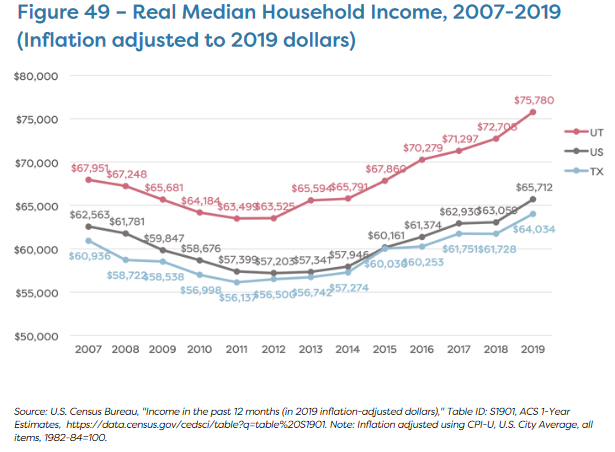
Even though Texas has a larger GDP per capita and ranks ahead of Utah for business climate, Utah has a higher share of people working and fewer people looking and unable to find work. Utah ranks 1st in the nation for income equality by the GINI Index, 1st for K-12 funding equity, and has fewer people living below the poverty line.
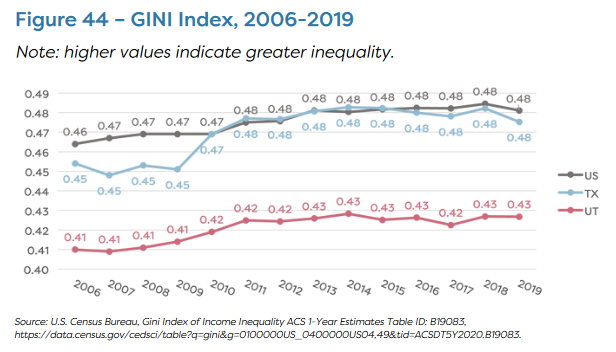
Utah is the clear winner by most standard of living measures. The most recent Kids Count overall ranking has Utah 4th and Texas 45th. Utah also has shorter commutes, higher homeownership rates, and more volunteerism and voter participation. Utah also has a much fairer tax system. Texas applies one of the highest tax rates in the nation (6th highest) to households with the lowest incomes and applies one of the lowest tax rates (9th lowest) to households with the highest income. This is because Texas has no personal or corporate income tax to offset the regressivity of their major revenue sources: sales, excise, and property taxes. As a result, Texas is one of the highest-tax states in the nation for lower-income residents, and one of the lowest-tax states for the wealthy.
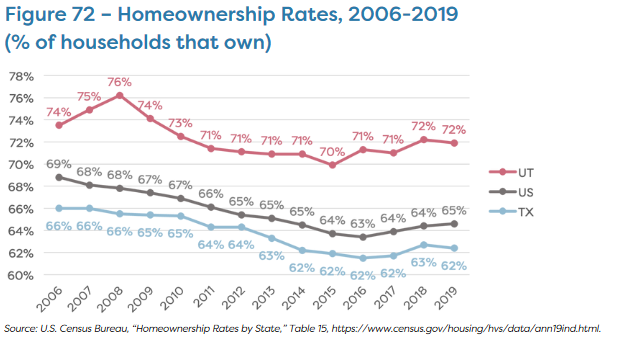
Can Utah Learn Any Lessons from Texas?
Texas leads in early childhood education for pre-k and full-day kindergarten participation. Texas also has a much smaller gender wage gap than Utah, which ranks as one of the worst states for gender equality. When disaggregated by race and ethnicity, Texas has a smaller gender wage gap than Utah for every race and ethnicity except Latino and Native Hawaiian and Pacific Islander women.

Policy Implications
Strengthening the Labor Force
Utah and Texas are both far below the national average for median (50th percentile) and 10th percentile hourly wages, likely due to the fact that both are among the 20 states that never raised their minimum wages above the 2009 federal minimum of just $7.25 (now at its lowest level since 1956), and both states are among the 27 that discourage union membership through “right-to-work” laws.
Addressing the Legacy of and Present Barriers Causing Racial & Ethnic Gaps
Racial and ethnic gaps are evident in almost every outcome where race and ethnicity are disaggregated, such as high school graduation rates, wages, gender pay gaps, poverty rates, and uninsured rates. It is important to note that these gaps were caused by social, economic, and political structures and policies that have perpetuated racial inequality, elaborated in our report. Such policies have had very serious consequences for people of color, especially children of color. And as in the rest of the nation, the COVID-19 pandemic has exacerbated these hardships. Addressing these gaps through investments in early childhood and K-12 education, specifically where there is a high concentration of children of color (which includes many communities along the Wasatch Front, including Ogden, Salt Lake City, South Salt Lake, West Valley City, Midvale, and Provo) would likely increase educational attainment, wages, and standard of living overall and would therefore contribute to reducing racial and ethnic gaps in the future.
Restoring Education Funding Effort
The link between education and income is well-established. States with higher education levels generally have higher levels of worker productivity, wages, and incomes. Voices for Utah Children has demonstrated elsewhere that Utah’s education funding effort has fallen from top 10 in the nation in the 1990s to the bottom 10 states today. While Utah “does more with less” in education compared to other states, will we be able to continue to advance without addressing the underfunding in our public education system? Utah has racial/ethnic educational outcome gaps which are larger than the national average, our pupil-to-teacher ratio is 3rd worst in the nation at 23:1 vs the national average of 16:1, and teacher pay has also fallen by 2% over the past 50 years, while teacher salaries nationally have increased 7%.
At the college level, Utah historically was always ahead of the national average for attainment of bachelor’s degrees and above. But Census data show Utah’s lead shrinking relative to the nation with each successive generation, to the point now that Utah millennials (ages 25-34) have fallen behind their peers nationally, despite relatively generous state support and low tuition levels. In addition, for young adults who do not seek to complete a college degree, apprenticeships and other skilled training programs or ensuring state contracts pay the prevailing local wage are two policies that have proven their value for achieving higher wages.
Can Utah Become a High-Wage State?
Utah has gone from being a low-wage state a generation ago to middle-wage status today, a considerable accomplishment. One question Utah leaders may now wish to consider is, is that good enough? Should we declare, “Mission Accomplished”? Or is Utah in a position, like Colorado and Minnesota before us, to become, over time, a high-wage state and set our sights on taking the necessary steps today to achieve that goal over the years and decades to come?
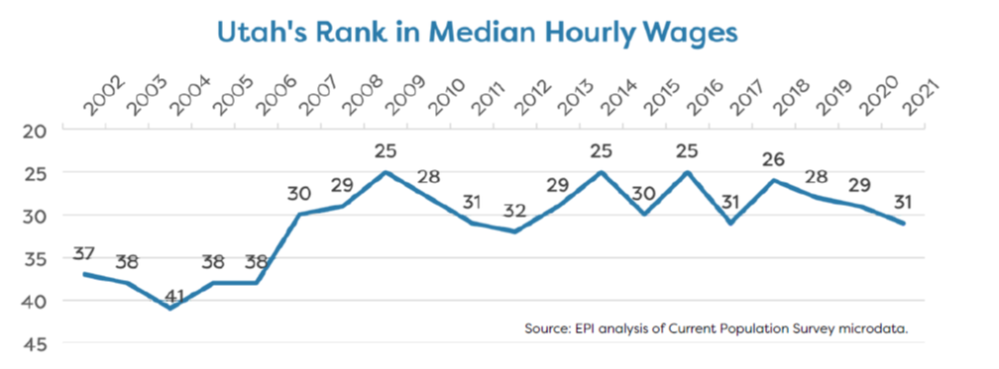
Similarly, how do we include those earning the lowest wages in the gains Utah has made and will potentially make in the future? Utah is not even a half percentage point lower than the national share of workers earning poverty-level wages and lags behind the nation’s 10th percentile wage, ranking 33rd. Even as the state with the lowest income inequality ranking in the nation, Utah suffers from a tremendous gap between low-income workers and the rest of the income scale.
The main lesson that emerges from the Working Families Benchmarking Project reports comparing Utah to Colorado, Minnesota, Idaho, Arizona and now Texas is the following: Higher levels of educational attainment translate into higher hourly wages, higher family incomes, and an overall higher standard of living. The challenge for policymakers is to determine the right combination of public investments in education, infrastructure, public health, and other critical needs that will enable Utah to continue our progress and achieve not just steady growth in the quantity of jobs, but also a rising standard of living that includes moderate- and lower-income working families from all of Utah’s increasingly diverse communities.
The 41-page report is available for download here.
MEDIA COVERAGE OF THE BENCHMARKING PROJECT:
The Spectrum: https://www.thespectrum.com/story/news/2022/09/02/report-compares-utah-texas-economy-standard-living-homes-jobs/7970912001/
KSL News Radio: https://kslnewsradio.com/1974565/new-report-ranks-utah-above-texas-in-aspects-of-economic-opportunity-and-standard-of-living/
Salt Lake Tribune: https://www.sltrib.com/opinion/commentary/2022/09/15/matthew-weinstein-taylor-throne/
100% Kids Coverage Storybook
Families living with health insurance, and without: New storybook highlights why all Utah children need health insurance
Throughout the pandemic, health insurance has been a critical lifeline for Utah families to stay healthy and avoid medical debt. Yet many Utah children and parents are still unable to access any form of health insurance; they are denied coverage due to their immigration status. A new digital storybook, released by Voices for Utah Children, highlights families’ real-life experiences with health insurance and medical care. The stories reveal how having health insurance- or not having it- can alter a child’s life course.
The digital book is a collection of accounts shared by children, parents and caregivers across Utah. To protect the privacy and sensitive material shared, names were changed. The book includes accounts of children growing up without health insurance; the short and long-term positive impact of CHIP and Medicaid for children; immigrants and asylees finding the care they need; and children being denied care due to immigration status, while their siblings born in the United States can access care.
The storybook humanizes a problem that is often ignored: today in Utah, thousands of Utah children are still shut out of health coverage. As one DACA- recipient recounts in the book, growing up her families was “Too scared of the cost to go to the ER.”
However, there are glimpses of hope on the horizon. In the 2022 General Session, the Utah Legislature considered a bill that would allow all income-eligible children to enroll in Medicaid or CHIP, regardless of their background or immigration status. The bill, sponsored by Senator Luz Escamilla and Representative Mike Schultz, passed the Senate with broad support, but ran out of time in the House.
The book lifts up the stories behind the 2022 legislation. Previous reports from Voices for Utah Children have estimated the significant state savings if all children have coverage. The digital storybook shows the emotional, physical and financial costs families pay when their children are denied health insurance, and the life-changing benefits when families are able to get coverage.
What happened to Coverage for All Kids this Session?
This Session, one of Voices for Utah Children’s top priority bills received very little public attention despite its behind-the-scenes activity. Below we will unpack what happened, lessons we learned, and what we believe the path forward should be so we can reach 100% Kids Coverage in Utah.
First a little background, during the 2021 Legislative Session, we were thrilled to see many statements in support of children’s health insurance coverage. Speaker Wilson highlighted children’s coverage and Utah’s high rate of uninsured kids during his opening Session remarks and supported funding for CHIP outreach. On the Senate side, Senator Escamilla championed a bill to Cover All Kids, which former House Leader, Representative Gibson, sponsored on the House side. While the bill did not make it through in the final days of the Session, it seemed well-positioned to pass in 2022.
Onto 2022…
This year Senator Luz Escamilla ran Senate Bill 185. Like her bill last year, SB 185 ensured all Utah children could get covered and stay covered by allowing income -eligible Utah children access to Medicaid and CHIP, regardless of immigration status. In addition, SB 185 restored funding for continuous eligibility for Medicaid children. Senator Escamilla skillfully navigated SB 185, with approval from the Senate Revenue and Taxation Committee and broad support on the Senate floor. On the House side, Majority Leader, Representative Mike Schultz, stepped up as the House Sponsor to usher the bill across the finish line. But unfortunately, the bill was never brought to the full floor for a vote in the House.
So what happened this year?
Although SB 185 made it out of the Senate with little objections or pushback, it ran into obstacles in the House. The bill arrived in the House without enough time for a committee hearing. While it could have gone through without one, members of the House did not have the full time to discuss and familiarize themselves with the bill and work through question or concerns. Although the bill never came to the floor for a full vote, it did have strong bipartisan support. Cover All Kids got even closer this year, but still fell short.
Going forward, we must discuss any questions or concerns directly. We invite lawmakers to join us in having honest conversations about the children we are leaving behind in our state, the children we are deciding not to cover. All children growing up in Utah need health insurance to thrive, regardless of their immigration status. To deny some children access to health care is unconscionable.
It is time we amplify the many voices, the stories, the statewide energy and support for Covering All Kids. Lawmakers are ready; Utahns are ready. It’s time we act to Cover All Kids.
Learn more about the stories and join our campaign at https://www.100percentkids.health/take-action



